Physical Science I
Topic outline
-
Welcome to Physical Science I!
Course Introduction
Statewide Common Course Description: Physical Science I Survey of concepts in physics and chemistry.
Additional Description: This course introduces fundamental laws, modern theories, and principles of physical science. The emphasis will be concentrated on 1 & 2-D motion, Vectors, Newton’s Laws, Gravitation, Momentum, Work and energy, Thermodynamics, Waves, Electricity and Magnetism, Astronomy, and chemistry concepts in the areas of measurement, chemical and physical properties of matter, atomic and molecular structure, chemical equations and stoichiometry, reactions, energy relationships, periodicity, bonding, gas laws, and solutions. Integrated into the course are problem-solving and quantitative approaches. This course is intended for a non-science curriculum.
Upon successful completion of this course, the student will be able to:
- Course Learning Outcomes
- (CLO1) Explain and apply the basic laws and principles governing the nature of matter, motion, work and energy forms, waves, electricity, magnetism, and special topics in astronomy.
- (CLO2) Use a basic scientific vocabulary that relates to course content.
- (CLO3) Recognize and explain many physical phenomena observed in the physical environment.
- (CLO4) Use the scientific method in concert with the basic laws of physics to model, analyze, and interpret physical scenarios in the course materials to everyday life.
- (CLO5) Use simple mathematical skills to solve problems that pertain to the physical environment.
- (CLO6) Demonstrate a fundamental knowledge of chemistry concepts in the areas of measurement, chemical and physical properties of matter, atomic and molecular structure, chemical equations and stoichiometry, reactions, energy relationships, periodicity, bonding, gas laws, and solutions.
- (CLO7) Analyze and solve fundamental quantitative chemistry problems.
- (CLO8) Apply chemical principles to understanding natural phenomena, emerging chemistry-related technology, and materials encountered in everyday life.
Adopting an institution should provide learners information on how to navigate the course. Consider adding an introductory navigation video. Text description could include, for example:Navigating the Course
This course is set up in Modules covering various topics which may be accessed from the course navigation menu on the left or by scrolling below. Modules may be collapsed in the menu and it the body of the course to minimize scrolling. Each module includes the relevant chapters followed by various activities, which may include discussion forums, listening activities and quizzes, practice quizzes, module tests, and other relevant activities as appropriate for each module. Many items are required and may be marked as completed automatically when the activity has been submitted (the broken check box), but others will marked as done by the student (the solid check box).Please move through the items below and continue through the Learner Support and Getting Started modules before moving on to Module 1. Be sure to check for announcements and due dates to stay on track.
 This course and its contents, developed by authors Shirley Vides, Mostafa Elasaar, James Boffenmyer, and Editor: Esperanza M. Zenon, are licensed under a Creative Commons Attribution 4.0 International License by LOUIS: The Louisiana Library Network, except where otherwise noted.
This course and its contents, developed by authors Shirley Vides, Mostafa Elasaar, James Boffenmyer, and Editor: Esperanza M. Zenon, are licensed under a Creative Commons Attribution 4.0 International License by LOUIS: The Louisiana Library Network, except where otherwise noted. -
-
Adopting institution should provide learners information about data and privacy. Considerations include:
- Providing links to the institution's data retention and website privacy policies
- Providing a link to the LMS privacy policy (ex., Moodle Privacy Policy)
- Pressbooks Privacy Policy
- Providing links to privacy information for any multimedia sources used (e.g., YouTube)
An Example Technology Policies and Support Resources: Accessibility, Privacy, and Support/Help document has been provided and can be modified as needed.
-
This module contains all the items you should review and complete before you begin Module 1. Before moving on, be sure to:
- Check the News and Announcements Forum
- Read the Course Syllabus
- Introduce yourself to the class
- Read the instructions for the Q & A Forum
Good luck in the course!-
Use this forum to tell us a little about yourself and your interests. Some topic ideas:
- What is your field of study/research interest or concentration?
- What are you most interested in learning about in this class and why?
- Have you ever taken an online class before?
- Any other information you would like to share with your classmates, such as special interests or activities.
Post a picture! We look forward to meeting you.
-
Use this forum to ask your instructor any questions you have about the course. You may post at any time, and your instructor will respond here. Be as specific as possible.
Please keep in mind that others can see your posts, so do not post any personal information. If you have questions about your grade, please email your instructor directly. You can expect a response to posts and emails within 24 hours M-F, next business day on weekends.
- Check the News and Announcements Forum
-
Use the information in this module to customize the template to your needs. This module is currently hidden from students, and available for you to refer to throughout the semester.
-
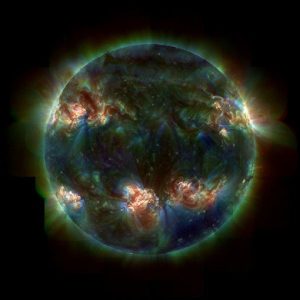
Fig 1.1 An image of the Sun taken in UV (Ultraviolet light) taken by the Transition Region and Coronal Explorer (TRACE) and combined with the data from the Stanford Lockheed Institute for Space Research.Chapter Outline
- The Nature of Science
- The Development of a Scientific Theory
- The Scientific Method
- Introduction to Measurements
- Measurement Uncertainty, Accuracy, and Precision
- Mathematical Treatment of Measurement Results
Upon completion of this module, you will be able to:
- List and Use the steps of the Scientific Method(CLO2)(CLO4)
- Estimate Physical Parameters (CLO2)(CLO3(CLO5)
- Solve simple problems using derived quantities (CLO2)(CLO5)
- Recognize and use SI Base Units and Prefixes (CLO2)(CLO5)
- Convert from one unit system to another. (CLO2)(CLO5)
- Use dimensional analysis to check the consistency of your work. (CLO5)
To achieve these objectives:
- Read and view Module 1: Chapter 1: The Nature of Science in Moodle
- Read Chapter 1: The Nature of Science in the Exploring the Physical World Introductory Chemistry and Physics Pressbook
- Complete the Module 1: Chapter 1: The Nature of Science Assignment
- Complete the Module 1: Chapter 1: The Nature of Science Discussion
- Complete the Module 1: Video (VWS) Assignment: The Nature of Science
- Complete the Module 1: Activity Assignment - Measurement
- Complete the Module 1: Report Assignment- Measurement
Note the checkboxes to the right that help you track your progress: some are automatic, and some are manual.
Module Pressbooks Resources and Activities
You will find the following resources and activities in this module at the Pressbooks website. Click on the links below to access or complete each item.
-

Figure 2.1 These cyclists in Vietnam can be described by their position relative to buildings and a canal. Their motion can be described by their change in position, or displacement, in the frame of reference. (credit: Suzan Black, Fotopedia)Chapter Outline
- Position
- Displacement
- Distance
- Time
- Velocity
- Average Velocity
- Speed
- Average Acceleration
- Acceleration as a Vector
- Instantaneous Acceleration
Upon completion of this module, you will be able to:
- Discuss the requirements for determining motion (CL02) (CL03)
- Define position, speed, velocity, and acceleration (CLO2)
- Define and compute distance (CLO2)(CLO5)
- Discuss the relationship between position, velocity, and acceleration of an object in motion (CLO2)(CLO3)
- Recognize and use proper units for position, speed, velocity, and acceleration (CLO2)(CLO5)
- Analyze motion graphs. (CLO2)(CLO5)
- Perform calculations using the kinematics equations for constant acceleration situations.(CLO2)(CLO5)
- Define free fall and solve free fall problems. (CLO2)(CLO5)
To achieve these objectives:
- Read and view Module 2: Chapter 2: Linear Motion
- Read Chapter 2: Linear Motion in the Exploring the Physical World Introductory Chemistry and Physics Pressbook
- Complete the Module 2: Chapter 2: Linear Motion Assignment
- Complete the Module 2: Chapter 2: Linear Motion Discussion
- Complete the Module 2: Video (VWS) Assignment: Linear Motion
- Complete the Module 2: Activity Assignment - The Moving Man
- Complete the Module 2: Report Assignment- The Moving Man
Note the checkboxes to the right that help you track your progress: some are automatic, and some are manual.
Module Pressbooks Resources and Activities
You will find the following resources and activities in this module at the Pressbooks website. Click on the links below to access or complete each item.
-
Figure 3.1 Newton’s laws of motion describe the motion of the dolphin’s path. (credit: Jin Jang) By: Rice University Openstax CC BY NC SA
Chapter Outline
- Newton's First Law of Motion
- Newton's Second Law of Motion
- Units of Force
- Newton's Third Law of Motion
- What it Means to Do Work
- What is Work?
- What is Power?
- Power
Upon completion of this module, you will be able to:- Explain and apply Newton's first, second, and third laws. (CLO1)(CLO2)(CLO3)
- Identify various forces in a diagram or problem (CLO2) (CLO3)
- Translate a free-body diagram into a mathematical representation. (CLO2)(CLO5)
- Calculate mass, weight, and force (CLO2)(CLO5)
- Explain what is meant by normal force. (CLO2)(CLO3)
- Explain the role that inertial plays in effecting motion (CLO2)(CLO3)
- Discuss the requirements for and consequences of balanced and unbalanced forces(CLO2) (CLO3)
- Calculate the net force acting on objects and their resulting accelerations. (CLO2)(CLO5)
- Identify action-reaction pairs (CLO2)(CLO3)
- Define and calculate work using appropriate SI units (CLO2)(CLO3)(CLO5)
- Discuss the components needed for work to occur (CLO2)(CLO3)
- Define and calculate power based on work and time. (CLO2)(CLO3)(CLO5)
To achieve these objectives:
- Read and view Module 3: Chapter 3: Force, Work, and Power
- Read Chapter 3: Force, Work, and Power in the Exploring the Physical World: Introductory Physics and Chemistry Pressbook
- Complete the Module 3: Chapter 3: Force, Work, and Power Assignment
- Complete the Module 3: Chapter 3: Force, Work, and Power Discussion
- Complete the Module 3: Video (VWS) Assignment - Force, Work, and Power
- Complete the Module 3: Activity Assignment - Force, Work, and Power
- Complete the Module 3: Activity Report - Force, Work, and Power
Note the checkboxes to the right that help you track your progress: some are automatic, and some are manual.
Module Pressbooks Resources and Activities
You will find the following resources and activities in this module at the Pressbooks website. Click on the links below to access or complete each item.
- Newton's First Law of Motion
-
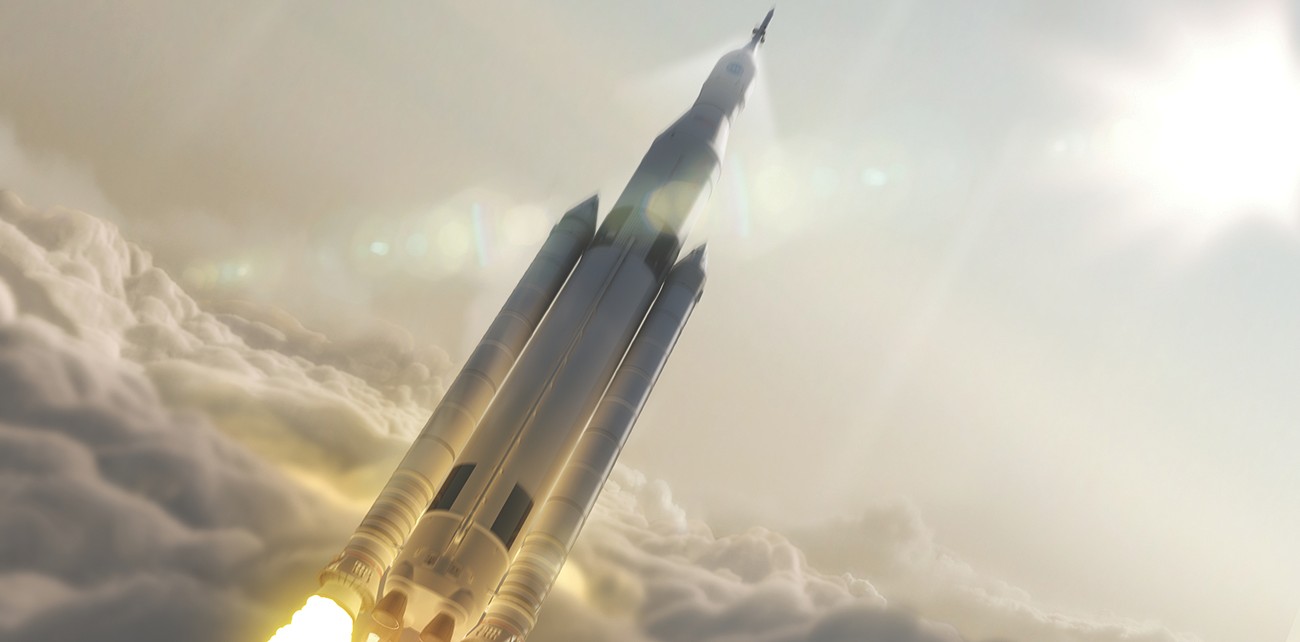
Figure 4.1 Many modern rocket fuels are solid mixtures of substances combined in carefully measured amounts and ignited to yield a thrust-generating chemical reaction. By: Rice University Openstax CC BY NC SA
Chapter Outline
- Physical and Chemical Changes
- Balancing Equations
- Types of Chemical Reactions
- Thermal Energy, Temperature, and Heat
Upon completion of this module, you will be able to:
- Write and balance chemical equations (CLO7)
- Define three common types of chemical reactions (precipitation, acid-base, and oxidation-reduction) (CLO6)
- Classify chemical reactions as one of these three types given appropriate descriptions or chemical equations (CLO6)(CLO7)
- Identify common acids and bases (CLO6)(CLO8)
- Define and distinguish between heat and temperature. (CLO2)(CLO3)
- Express temperature using Fahrenheit, Celsius, and Kelvin scales. (CLO2)(CLO5)
- Discuss heat transfer applications and relate them to phase changes of matter. (CLO2)(CLO3)
- Define methods of heat transfer: conduction, convection, and radiation. (CLO2)(CLO3)
To achieve these objectives:
- Read and view the Module 4: Chapter 4: Properties of Materials, Chemical Reactions, and Heat in Moodle
- Read Chapter 4: Properties of Materials, Chemical Reactions, and Heat in the Exploring the Physical World Introductory Chemistry and Physics Pressbook
- Complete the Module 4: Chapter 4: Properties of Materials, Chemical Reactions, and Heat Assignment
- Complete the Module 4: Chapter 4: Properties of Materials, Chemical Reactions, and Heat Discussion
- Complete the Module 4: Video (VWS) Assignment - Chemical Reactions
- Complete the Module 4: Activity Assignment - States of Matter
- Complete the Module 4: Report Assignment - States of Matter
Module Pressbooks Resources and Activities
You will find the following resources and activities in this module at the Pressbooks website. Click on the links below to access or complete each item.
-

Fig 5.1 Waves in the ocean behave similarly to all other types of waves. By: Steve Jurvetson is licensed under a CC BY (Attribution) licenseChapter Outline
- Wave Characteristics
- Electromagnetic Spectrum
- Transmission, Reflection, and Absorption
- Radio and TV Waves
- Ray
- Geometric Optics
- Refraction
- Speed of Light
- Lenses
- Ray Tracing and Thin Lenses
- Image Formation by Thin Lenses
- Sound
Upon completion of this module, you will be able to:
- Recognize that Waves Carry Energy, but not Matter (CLO1)
- Define Mechanical Waves (CLO1)
- Distinguish between Transverse Waves and Compressional Waves (CLO1)
- Compare and Contrast Transverse and Compressional Waves (CLO3)
- Describe the Relationship between Frequency and Wavelength (CLO3)
- Explain How a Wave’s Amplitude is Related to the Wave’s Energy (CLO3)
- Calculate the Speed of a Wave (CLO5)
- Identify What Influences The Speed of Sound (CLO3)
- Discuss and Apply Various Properties of Sound (CLO3)
- Identify the Properties of Electromagnetic Radiation (CLO3)
To achieve these objectives:
- Read and view Module 5: Chapter 5: Waves, Electromagnetic Radiation, and Sound in Moodle
- Read Chapter 5: Advanced Waves, Electromagnetic Radiation, and Sound in the Exploring the Physical World Introductory Chemistry and Physics Pressbook
- Complete the Module 5: Chapter 5: Waves, Electromagnetic Radiation, and Sound Assignment
- Complete the Module 5: Chapter 5: Waves, Electromagnetic Radiation, and Sound Discussion
- Complete the Module 5: Video (VWS) Assignment: Waves, Electromagnetic Radiation, and Sound
- Complete the Module 5: Activity Assignment - Waves, Electromagnetic Radiation, and Sound
- Complete the Module 5: Report Assignment- Waves, Electromagnetic Radiation, and Sound
Module Pressbooks Resources and Activities
You will find the following resources and activities in this module at the Pressbooks website. Click on the links below to access or complete each item.
-
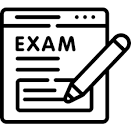 In this module, you will take your Midterm Exam.
In this module, you will take your Midterm Exam. Read the instructions carefully and take note of any special submission guidelines.
Exam icons created by Freepik - Flaticon
Upon completion of this module, you will have:
- Read and viewed the Midterm Exam instructions
- Prepared for and submitted your Midterm Exam
To achieve these objectives:
- Read and view the contents of "Exam Information and Instructions"
- Review the Midterm Exam guidelines in your syllabus to make sure you are ready.
- Click on Midterm Exam and follow the instructions.
-
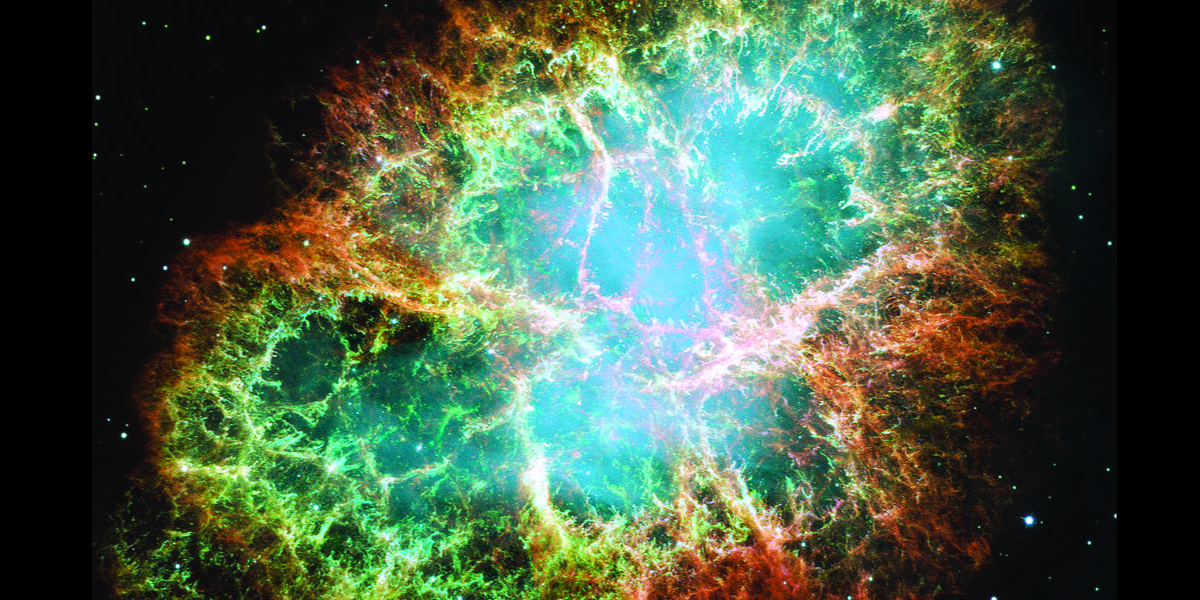
Figure 6.1 The Crab Nebula consists of remnants of a supernova (the explosion of a star). NASA’s Hubble Space Telescope produced this composite image. Measurements of the emitted light wavelengths enabled astronomers to identify the elements in the nebula, determining that it contains specific ions including S+ (green filaments) and O2+ (red filaments). By: Rice University Openstax CC BY NC SA
Chapter Outline
- Composition of the Atom
- Chemical Symbols
- Isotopes
- Atomic Mass
- Electron Configurations and the Periodic Table
Upon completion of this module, you will be able to:
- Describe the Electron Configuration of an Atom by using the Bohr Model (CLO2)(CLO6)
- Compute the Atomic Mass of an Atom (CLO5)(CLO6)(CLO7)
- Identify Isotopes of Common Elements (CLO6)(CLO7)(CLO8)
- Use the Periodic Table to Obtain Information (CLO6)(CLO8)
To achieve these objectives:
- Read and view Module 6: Chapter 6: The Atom and Elements in Moodle
- Read Chapter 6: The Atom and Elements in the Exploring the Physical World Introductory Chemistry and Physics Pressbook
- Complete the Module 6: Chapter 6: The Atoms and Elements Assignment
- Complete the Module 6: Chapter 6: The Atoms and Elements Discussion
- Complete the Module 6: Video (VWS) Assignment -
- Complete the Module 6: Activity Assignment - Isotopes and Atomic Mass
- Complete the Module 6: Report Assignment - Isotopes and Atomic Mass
Module Pressbooks Resources and Activities
You will find the following resources and activities in this module at the Pressbooks website. Click on the links below to access or complete each item.
-
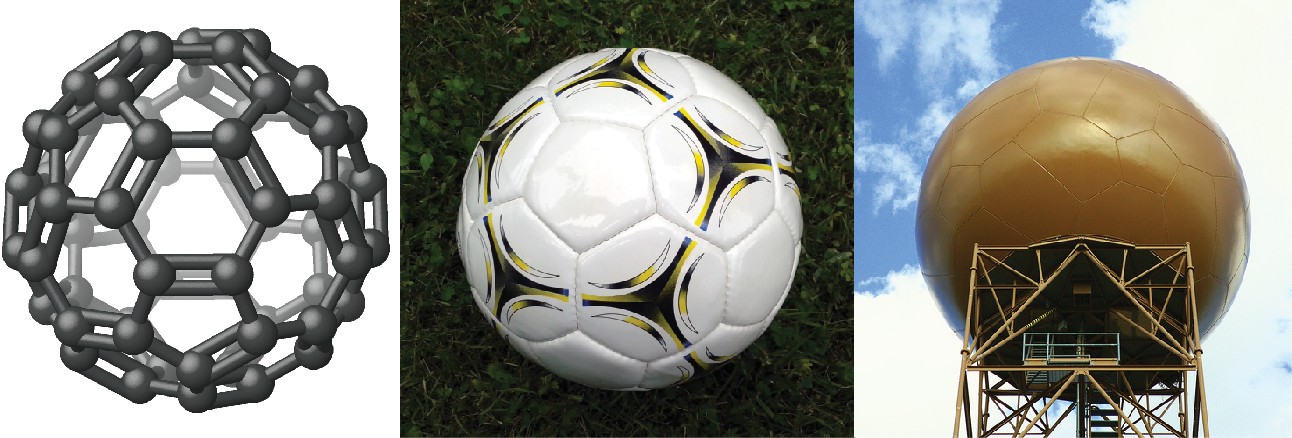
Figure 7.1 Nicknamed “buckyballs,” buckminsterfullerene molecules (C60) contain only carbon atoms (left) arranged to form a geometric framework of hexagons and pentagons, similar to the pattern on a soccer ball (center). This molecular structure is named after architect R. Buckminster Fuller, whose innovative designs combined simple geometric shapes to create large, strong structures such as this weather radar dome near Tucson, Arizona (right). By: Rice University Openstax CC BY NC SAChapter Outline
- Ionic and Molecular Compounds
- Ionic Compounds
- Molecular Compounds
- The Formation of Ionic Compounds
- Covalent Bonds
- Pure vs. Polar Covalent Bonds
- Metallic Bonds
- Electronegativity
- Lewis Symbols and Structures
- The Octet Rule
- Double and Tripple Bonds
Upon completion of this module, you will be able to:
- Define the Components and Types of Ionic Compounds (CLO6)
- Model Electron Configuration by using Lewis Structures (CLO6)(CLO7)
- Apply the Octet Rule for Lewis Structures (CLO6)(CLO7)
- Discuss everyday situations related to molecular structures (CLO8)
To achieve these objectives:
- Read and view Module 7: Chapter 7: Ionic and Molecular Compounds and Bonding in Moodle
- Read Chapter 7: Ionic and Molecular Compounds and Bonding in the Exploring the Physical World Introductory Chemistry and Physics Pressbook
- Complete the Module 7: Chapter 7: Ionic and Molecular Compounds and Bonding Assignment
- Complete the Module 7: Chapter 7: Ionic and Molecular Compounds and Bonding Discussion
- Complete the Module 7: Video (VWS) Assignment - Drawing Lewis Diagrams
- Complete the Module 7: Activity Assignment - Molecular Geometry
- Complete the Module 7: Report Assignment- Molecular Geometry
Note the checkboxes to the right that help you track your progress: some are automatic, and some are manual.
Module Pressbooks Resources and Activities
You will find the following resources and activities in this module at the Pressbooks website. Click on the links below to access or complete each item.
-

Figure 8.1 How many forms of energy can you identify in this photograph of a wind farm in Iowa? Jürgen from Sandesneben, Germany is licensed under a CC BY (Attribution)Chapter Outline
- Introduction to Energy
- Chemical Changes to Matter
- Forms of Energy
- Converting Between Kinetic and Potential Energy
- Mechanical Energy
- Calculating Kinetic and Potential Energy
- Conservation of Energy and Matter
- Transformation of Energy
- Conservation of Mass
Upon completion of this module, you will be able to:
- Explain and apply the Law of Conservation of Energy (CLO1)(CLO2)(CLO3)(CLO5)(CLO6)
- Define energy, kinetic energy, and gravitational potential energy (CLO2)(CLO3)
- Analyze situations that involve kinetic and potential energy. (CLO2)(CLO3)
- Calculate kinetic and potential energies. (CLO2)(CLO5)
- Discuss the conservation of mass (CLO1)(CLO6)
To achieve these objectives:
- Read and view the Module 8: Chapter 8: Matter and Energy in Moodle
- Read Chapter 8: Matter and Energy in the Exploring the Physical World Introductory Chemistry and Physics Pressbook
- Complete Module 8: Chapter 8: Matter and Energy Assignment
- Complete Module 8: Chapter 8: Matter and Energy Discussion
- Complete the Module 8: Video (VWS) Assignment - Conservation of Energy
- Complete the Module 8: Activity Assignment - Energy Forms and Changes
- Complete the Module 8: Report Assignment - Energy Forms and Changes
Module Pressbooks Resources and Activities
You will find the following resources and activities in this module at the Pressbooks website. Click on the links below to access or complete each item.
-
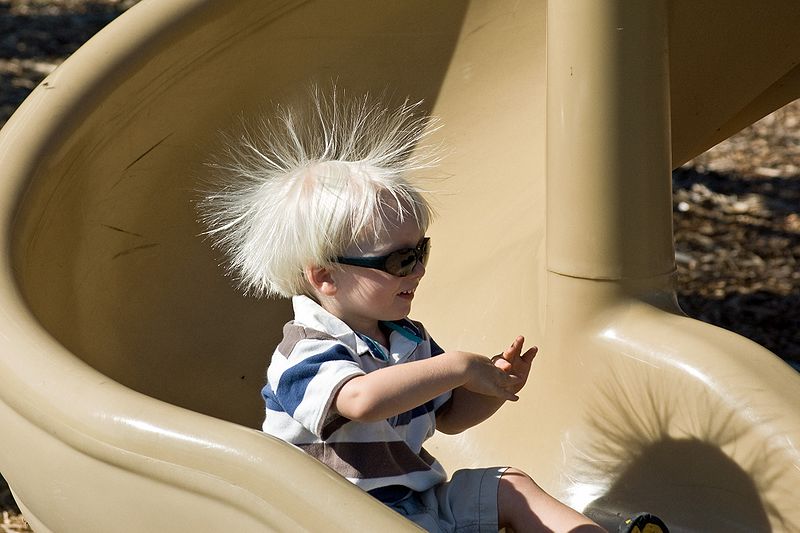
Figure 9.1 Fig. 9.1 Static electricity from this plastic slide causes the child’s hair to stand on end. The sliding motion stripped electrons away from the child’s body, leaving an excess of positive charges, which repel each other along each strand of hair. (credit:)Chapter Outline
- Introduction to Electricity
- Static Electricity and Conservation of Charge
- Charge Carried by Electrons and Protons
- Separation of Charges in Atoms
- Coulomb's Law
- Electric Field and Electric Forces
- Electric Current and Electric Circuitry
- Ohm's Law
- Resistance and Simple Circuits
- Resistors in Parallel and In Series
- Direct Current and Alternating Current
- Voltmeters and Ammeters
Upon completion of this module, you will be able to:
- Define: static electricity (CLO2)(CLO3)
- Determine the type of electric charge present (CLO2)(CLO3)(CLO4)
- State units of charge and electric force in SI units. (CLO2)(CLO5)
- Explain various electrostatic interactions (CLO2)(CLO3)
- Define: electrical force, and electric field (CLO2)
- State Coulomb’s Law (CLO1)(CLO2)
- Discuss the relationships between the variables in Coulomb’s Law equation. (CLO2)(CLO3)(CLO5)
- Describe interactions between charges and electric fields. (CLO2)(CLO3)
- Use Coulomb’s Law to calculate electric force (CLO5)
- Compare the Coulomb Force to the Gravitational Force (CLO2)(CLO3)(CLO5)
- Define electric current, electric resistance, and voltage. (CLO2)(CLO3)
- State Ohm’s Law. (CLO1)
- Use the correct units of current, voltage, and resistance in the metric systems. (CLO5)
- Explain the relationships between the variables in the Ohm’s Law formula (CLO2)(CLO3)
- Use Ohm’s Law to solve simple circuit problems (CLO5)
- Determine the electric resistance, voltage, electric current, and power in a circuit (CLO2)(CLO3)(CLO5)
- Discuss the relationship between energy, power, voltage, current, and resistance in a circuit. (CLO2)(CLO3)
- Describe and differentiate between parallel and series electrical circuits. (CLO2)(CLO3)
- Determine the equivalent resistance for series and parallel combinations of resistors. (CLO2)(CLO5)
- Determine the frequency, electric resistance, voltage, and electric current in a simple AC circuit (CLO2)(CLO3)(CLO5)
-
Explain the function of a coil, resistor, and capacitor in a circuit (CLO2)(CLO3)
To achieve these objectives:
- Read and view the Module 9: Chapter 9: Electricity and Electrical Circuits in Moodle
- Read Chapter 9: Electricity and Electrical Circuits in the Exploring the Physical World Introductory Chemistry and Physics Pressbook
- Complete Module 9: Chapter 9: Electricity and Electrical Circuits Assignment
- Complete Module 9: Chapter 9: Electricity and Electrical Circuits Discussion
- Complete the Module 9: Video (VWS) Assignment - Electricity and Electrical Circuits
- Complete the Module 9: Activity Assignment - Electricity & Electrical Circuits
- Complete the Module 9: Report Assignment - Electricity & Electrical Circuits
Module Pressbooks Resources and Activities
You will find the following resources and activities in this module at the Pressbooks website. Click on the links below to access or complete each item.
-

Figure 10.1 The magnificent spectacle of the Aurora Borealis, or northern lights, glows in the northern sky above Bear Lake near Eielson Air Force Base, Alaska. Shaped by the Earth’s magnetic field, this light is produced by radiation spewed from solar storms. Joshua Strang, USAF is licensed under a CC BY (Attribution) license
Chapter Outline
- Introduction to Magnetism
- Magnets
- Ferromagnets
- Electromagnets
- Current: Source of All Magnets
- Magnetic Fields and Magnetic Field Lines
- Magnetic Field Rules
Upon completion of this module, you will be able to:
- Define: magnetic force (CLO1)(CLO2)(CLO3)
- Explain the effects of magnetic fields on moving charge (CLO2)(CLO3)
- Describe and differentiate between DC and AC current. (CLO2)(CLO3)
- Explain how a transformer works, and solve problems using the transformer formula. (CLO2)(CLO3)(CLO5)
- Describe how electric motors work and the role of magnetism in their function. (CLO2)(CLO3)
To achieve these objectives:
- Read and view the Module 10: Chapter 10: Magnetism in Moodle
- Read Chapter 10: Magnetism in the Exploring the Physical World Introductory Chemistry and Physics Pressbook
- Complete Module 10: Chapter 10: Magnetism Assignment
- Complete Module 10: Chapter 10: Magnetism Discussion
- Complete the Module 10: Video (VWS) Assignment - Magnetism
- Complete the Module 10: Activity Assignment - Magnetism
- Complete the Module 10: Report Assignment - Magnetism
Module Pressbooks Resources and Activities
You will find the following resources and activities in this module at the Pressbooks website. Click on the links below to access or complete each item.
-
 In this module, you will take your Final Exam.
In this module, you will take your Final Exam. Read the instructions carefully and take note of any special submission guidelines.
Exam icons created by Freepik - Flaticon
Upon completion of this module, you will have:
- Read and view the Final Exam instructions
- Prepared for and submitted your Final Exam
To achieve these objectives:
- Read and view the contents of "Exam Information and Instructions"
- Review the Final Exam guidelines in your syllabus to make sure you are ready.
- Click on Final Exam and follow the instructions.
